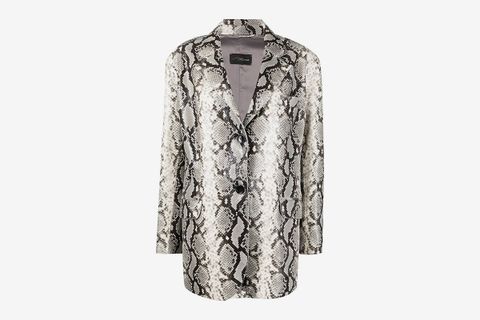An Eternal Ode to Ryuichi Sakamoto's Underrated Style
This article, published in 2021, has been updated to reflect Ryuichi Sakamoto's passing on March 28, 2023
Chances are you’ve listened to some of Ryuichi Sakamoto’s music. Whether or not you’re familiar with the pioneering Japanese pianist and founding member of the Tokyo-based vanguard electro-synth-pop three-piece Yellow Magic Orchestra — aka YMO, aka Not YMO, aka YMO (very, very etc.) — the probability that you’ve managed to go your whole life up until this very point having never heard a single note of his work is so low that it hardly bears consideration.
Chances are that you’ve seen Sakamoto, too. And, if you have, you’ve inevitably admired his style. If not, well, you probably weren’t looking closely enough. From the flamboyant glam of the ’80s to the chic black high-neck and distinctive tortoiseshell glasses that make up his signature look these days, there’s not one bad outfit in the bunch.
Across a career that spans almost 46 years, Sakamato, 71 years old at the time of his passing, has been so prolific and so relentlessly driven in his passion for music that it’s hard to imagine what it might sound like without him: the production style of his early solo albums are often and rightly name-checked as a jumping-off point in the history of not only electro and IDM (heavily influencing the likes of Aphex Twin), but also of hip-hop.
Sakamoto’s achievements are far from relegated to the past: in the last 10 years alone, he has released two full-length studio albums, two live albums, four compilations, and 12 film soundtracks — including the Golden Globe-nominated score for the grunting, man-fights-bear drama The Revenant (with frequent collaborator Alva Noto) and music for “Smithereens,” an episode of that uniquely 21st-century pop-culture touchstone Black Mirror. In that time, he’s also worked with Oneohtrix Point Never, the musical director of The Weeknd’s Super Bowl 2021 Half-Time Show and composer of the vertigo-inducing Uncut Gems soundtrack, with both artists reworking a track composed by the other.
Considering that there isn’t a bum note in the canon, this would be impressive under any circumstances. That Sakamoto also spent a significant portion of that time fighting, beating, and then recovering from throat cancer only makes it more so. After being diagnosed with the illness for a second time in January, Sakamoto said he would push ahead on making new music.
Despite a career spanning four decades, Sakamoto is a uniquely contemporary artist. If you’ve ever seen a photograph of the Tokyo maestro, you’ll have noticed that he also knows a thing or two about style.
Sakamoto’s first solo album — released in 1983, the same year as YMO’s debut — came with a cover that owes more to Speaking In Tongues-era David Byrne than to the Kraftwerk aesthetic preferred by Yellow Magic. Less robots and primary colors, more ambient lighting and modern takes on tailoring.
Wearing a check blazer and a red tie loosened at the collar while holding a lamp precariously over a luxurious bubble bath, it’s about as bold a statement as you can make in muted colors with brown shoes and turn-ups. Perfectly balanced with the record itself, the cover is a testament to Sakamoto’s artistic sensibilities, his sense of humor, and his fashion sense. A Pitchfork review of the album’s reissues notes, “As with all of Sakamoto’s work, there’s no distinction between pop and experimentalism,” and while the article is referring to the music, the same holds true for Sakamoto’s style: distinctly of-the-moment, but always slightly off-kilter.
It’s worth mentioning, too, that even before Knives, on the 1980 split single “War Head/Lexington Queen,” Sakamoto was already working to warp visual perceptions and subvert expectations; the subtle switch between the A and B sides lined up and knocked down macho stereotypes not just with ease and style, but with a sartorial flare for the dramatic.
It’s not so much a signature look, but a signature style language — one that compels you to look twice at what you might have missed, in the same way that his music, beautiful enough on the surface, demands relistening to access the depths and hidden flourishes that make it so exceptional.
Consider this suit — worn to the premier of 1998's Nicholas Cage-starring conspiracy thriller Snake Eyes, for which Sakamoto composed the score (easily a contender for the movie’s most convincing performance). It’s a purple suit with a gray T-shirt; the kind of tailoring-made-casual combination more or less ubiquitous in the ’80s and ’90s, found everywhere from Miami Vice to Friends.
While the movie is bland enough you only need to watch it once (and even then “need” is a very strong word), the suiting (which, judging by the pleats could well be an Issey Miyake number) and the overall fit warrants a second, closer viewing.
First of all, the coloring. Purple? Inspired. Not a neon or ultraviolet, but a purple in the truest sense of the word — dark, brooding, like the ocean at night or the last few seconds of a California sunset — with ripples in the silk of the jacket and the pants, like waves or clouds, giving the illusion of movement. That gray T-shirt? Genius. Not just a perfect match to the brighter streaks of Sakamoto’s salt-and-pepper locks, but an ideal companion designed to bring out the pearly sheen of the silk without overdoing it. All offset with a belt so blue that you know it must have been chosen to really hammer home the depth of that purple, just in case you had any creeping doubts that the suit itself was navy. And that might just be a crime worse than this movie.
Naturally, much is made of Sakamoto’s illustrious and varied collaborators in music. And why wouldn’t it be? David Sylvian, David Bowie, and David Byrne — to name only three Davids from a long list of co-conspirators — along with other household names like Public Image Ltd. and Massive Attack, as well as the considerably more underground Christian Fennesz, have all found themselves creatively entangled with com over the years in one way or another.
But Sakamoto’s artistic kinships extend well beyond the realm of the sonic, counting Yohji Yamamoto, Kenzō Takada, and Rei Kawakubo as friends and peers — although the latter, to his quiet frustration, has thus far eluded him as a collaborator. “My music is too musical for her… She would want something more deconstructed. For her, I understand that,” he told Dazed back in 2019.
Still, two out of three ain’t bad. His dark, ambient score for Yamamoto’s 1995 presentation is a standout example of two art forms coming together as one, in perfect harmony, in the hands of two visionary talents. His friendship with Takada, too, is longstanding and well-documented; the late designer considered the composer a muse, going so far as to release a “Ryuichi Sakamoto” jacket for Spring/Summer 2018, and Sakamoto himself — who starred in the Kenzo x H&M campaign two years previous — was profoundly affected by the news of Takada’s passing in 2020.
But it’s not only Sakamoto’s friends who are keen to dress him in their clothes or take his work as inspiration for their own. Sakamoto has appeared not only on the cover of more obvious titles like WIRED and Keyboard Magazine, but also T, Esquire, and The New Order, decked out in labels such as Louis Vuitton.
In 2019, the composer appeared in Opening Ceremony’s Fall/Winter 2019 ready-to-wear lookbook — a tribute to the founders’ Asian heritage. A fitting pairing, considering that Sakamoto composed music for the 1992 Barcelona Olympics, and a nod to the Japanese icon’s well-earned place in worldwide pop-culture history.
Sakamoto’s assigned look is typically low-key, but with the kind of eccentric accents that have consistently set him apart in everything he does for over 40 years. While the loose-fitting gray trackpants and track jacket come to the foreground — typical of Opening Ceremony’s approach to luxury leisure with an athletic touch — it’s the snake-print sneakers and the just-in-sight zip-through knitwear that really draw your eye back in for that second look..
All things come full circle eventually. Like a single refrain, played in a thousand different ways. Ever-changing, always evolving. A sense of style forever enduring.



